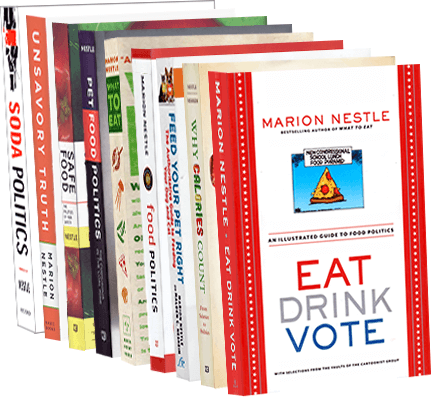The government must have announced the members of the committee that will develop the 2010 Dietary Guidelines for Americans, because the American Society of Nutrition (I am a member) has issued a press release congratulating the nine (of 13) appointees who are ASN members. Who are the other four? We will find out next week when the committee starts meeting. Stephen Clapp interviewed me about the Guidelines for Food Chemical News (October 27). Here’s my part of his article, subtitled, “Keep it simple, stupid!”
“Not everyone is happy with the 2005 guidelines. Marion Nestle, a high-profile nutritionist who teaches at New York University, favors scrapping the current advice in favor of something much simpler. She served on the 1995 Dietary Guidelines Advisory Committee, an experience she described in her book Food Politics. She hasn’t been invited back.
“I would hope for an enormous reversal of the last set of guidelines,” she told FCN. “They’re unteachable and incomprehensible. Buried in the 41 recommendations is the basic advice: eat less, move more, eat more fruits and vegetables and whole grains, and don’t eat too much junk food.
“The idea that this document is for policymakers is ridiculous,” she continued. “You could boil it down to a single recommendation: ‘Drink fewer sodas and juice drinks.'”
Nestle said in 1995 the advisory committee was told to interpret nutrition science for the public. In 2005 the panel was told to make “science-based” recommendations, she said, which she interprets as code for “We won’t let you say anything unless the science is incontrovertible.”
Basing the guidelines on Dietary Reference Intakes (DRIs) is a “huge mistake,” Nestle says, because the DRIs are “incomprehensible” and set too high for calcium and potassium, resulting in a recommendation to eat two or three servings of dairy products daily. “If the Dietary Guidelines have to be based on the DRIs, it’s too much food,” she says.
Nestle says nutrition science is unusually subject to interpretation and bias because it’s difficult to link specific nutrients to chronic diseases. “My biases are open,” she says. “Everyone else has biases, too, but they may not want to disclose them. The public is deeply confused — you should just give the best advice you can. Just take into consideration all the research available and don’t worry about the impact on one industry or another.”
Now wouldn’t it be useful if they took my advice? I will be following this story with great interest.
Update 10/28: Here’s the USDA’s announcement of the full list of committee members.
 Big Food companies have gotten together and agreed on a scoring system to identify “better-for-you” packaged foods (see below). Thanks to my colleague in Copenhagen, Morten Strunge Meyer (MortenCopenhagen), for sending the link to the qualifying crieteria. As is true of scoring systems in general, these are complicated and constitute a slippery slope. Take sodium, for example. The allowance is particularly generous (junk foods don’t taste good without it) – 480 mg per serving. That means 479 mg qualifies and that’s still nearly half a gram.
Big Food companies have gotten together and agreed on a scoring system to identify “better-for-you” packaged foods (see below). Thanks to my colleague in Copenhagen, Morten Strunge Meyer (MortenCopenhagen), for sending the link to the qualifying crieteria. As is true of scoring systems in general, these are complicated and constitute a slippery slope. Take sodium, for example. The allowance is particularly generous (junk foods don’t taste good without it) – 480 mg per serving. That means 479 mg qualifies and that’s still nearly half a gram.

